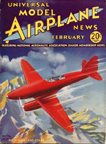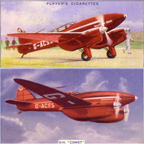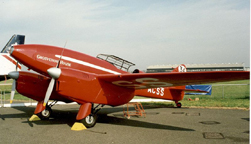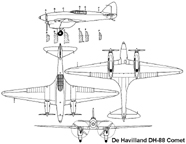February, 1935

Dehaviland DH. 88 "Comet"
Model Airplane News Cover Art for February, 1935
by Jo Kotula
Click to Enlarge
The de Havilland DH.88 Comet was a twin-engined British aircraft that won the 1934 MacRobertson Air Race, a challenge for which it was specifically designed. It set many aviation records during the race and afterwards as a pioneer mail plane



Photos of the Dehaviland DH. 88 "Comet"
Click to Enlarge
Some understanding of the nature of the race is essential to understanding this plane as well as the Bellanca "Irish Swoop", one of the other contestants to be featured on the cover of M.A.N. In order to celebrate the 100th Anniversary of the founding of the City of Melbourne, the city fathers organized an air race from London to Melbourne with mandatory stops at all key parts of the British Empire (e.g. Gibraltar, Malta, Alexandria, Baghdad, Karachi, Singapore, etc, etc. This was not only a test of the endurance of an airplane but also of its fitness to serve in the transport of mail and passengers within the Empire. Military considerations were a barely submerged subtext. The event was sponsored by the MacRoberts Chocolate factory and was widely heralded in the press. The entrants were seen in the press, the newsreels and even on trading cards. Click here to download a ".pdf" that gives the full details of the race.

Dehaviland DH. 88 "Comet"
in Popular Mechanics November, 1935
Click to Enlarge
Despite previous British air racing successes, culminating in 1931 in the outright win of the Schneider Trophy, there was no British plane capable of putting up a challenge over the MacPherson course with its long overland stages. The de Havilland company stepped into the breach by offering to produce a limited run of 200 mph racers if three were ordered by February 1934. Three orders were indeed received, and de Havilland set to work. The airframe consisted of a wooden skeleton clad with spruce plywood, with a final fabric covering on the wings. A long streamlined nose held the main fuel tanks, with the low set central two-seat cockpit forming an unbroken line to the tail. The main undercarriage retracted upwards and backwards into the engine nacelles. The DH.88 could maintain altitude up to 4,000 ft on one engine. The sale price of £5,000 each did not come close to covering the development costs. To salvage the situation, de Havilland suggested a high-speed bomber version of the DH.88 to the RAF With the peacetim austerity defense budgets but the suggestion was rejected. (De Havilland later developed the famed Mosquito along similar lines as the DH.88.
De Havillands had only six weeks to complete production and testing before the start date. On the day of the race, three distinctively coloured planes took their places among 17 other entrants ranging from a new Douglas DC-2 airliner to converted bombers. The most famous of the three D.88s was number G-ACSS "Grosvenor House" which won the race and is preserved today.
Here is a video of the Dehaviland DH. 88 "Comet":
Click Here for more information about the Dehaviland DH. 88 "Comet".

Click to go back and select another cover.
Counter for the Entire Site (not just this page..)
Home | About Lindy | Last Week's Reviews | Upcoming Events | 1940s Collecibles
The Guide - Establishments - Travel - Accessories
Music | Links | Photo Gallery | Extras | Contact